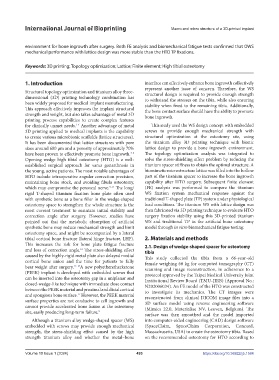Page 501 - IJB-10-1
P. 501
International Journal of Bioprinting Macro and micro structure of a 3D-printed implant
environment for bone ingrowth after surgery. Both FE analysis and biomechanical fatigue tests confirmed that OWS
mechanical performance with lattice design was more stable than the HTO TP fixations.
Keywords: 3D printing; Topology optimization; Lattice; Finite element; High tibial osteotomy
1. Introduction interface can effectively enhance bone ingrowth collectively
represent another issue of concern. Therefore, the WS
Structural topology optimization and titanium alloy three- structural design is required to provide enough strength
dimensional (3D) printing technology combination has to withstand the stresses on the tibia, while also ensuring
been widely proposed for medical implant manufacturing. stability when fixed to the remaining tibia. Additionally,
This approach effectively improves the implant structural the bone contact surface should have the ability to promote
strength and weight, but also takes advantage of metal 3D bone ingrowth.
printing process capabilities to create complex features
for clinically unmet needs. Another advantage of metal This study used the WS design concept with embedded
1-4
3D printing applied to medical implants is the capability screws to provide enough mechanical strength with
to create various microbionic scaffolds (lattice structures). structural optimization at the osteotomy site, using
It has been documented that lattice structures with pore the titanium alloy 3D printing technique with bionic
sizes around 600 µm and a porosity of approximately 70% lattice design to provide a bone ingrowth environment.
have been proven to effectively promote bone ingrowth. The topology optimization analysis was integrated to
4-8
Opening wedge high tibial osteotomy (HTO) is a well- solve the stress-shielding effect problem by reducing the
established surgical approach for varus gonarthrosis in titanium spacer stiffness to obtain the optimal structure. A
the young, active patients. The most notable advantages of biomimetic microstructure lattice was filled into the hollow
HTO include intraoperative angular correction precision, part of the titanium spacer to increase the bone ingrowth
maintaining bone stock, and avoiding fibula osteotomy, capability after HTO surgery. Subsequent finite element
which may compromise the peroneal nerve. 9-11 The long/ (FE) analysis was performed to compare the titanium
rigid T-shaped titanium fixation bone plate often used WS fixation system mechanical response against the
with synthetic bone as a bone filler in the wedge-shaped traditional T-shaped plate (TP) system under physiological
osteotomy space to strengthen the whole structure is the load conditions. The titanium WS with lattice design was
most current treatment to maintain initial stability and then fabricated via 3D printing technique to evaluate HTO
correction angle after surgery. However, studies have surgery fixation stability using this 3D-printed titanium
pointed out that the metabolic absorption of artificial WS and traditional TP in the artificial bone osteotomy
synthetic bone may reduce mechanical strength and limit model through in vitro biomechanical fatigue testing.
osteotomy space, and might be accompanied by a lateral
tibial cortical bone fracture (lateral hinge fracture, LHF). 2. Materials and methods
This increases the risk for bone plate fatigue fracture 2.1. Design of wedge-shaped spacer for osteotomy
12
and loss of correction angle. The stress-shielding effect tibia
caused by the highly-rigid metal plate also delayed medial This study collected the tibia from a 66-year-old
cortical bone union and the time for patients to fully female weighing 68 kg for computed tomography (CT)
bear weight after surgery. 12-16 A new polyetheretherketone scanning and image reconstruction, in adherence to a
(PEEK) implant is developed with embedded screws that protocol approved by the Taipei Medical University Joint
can be inserted into the osteotomy gap in a uniplanar and Institutional Review Board (TMU-JIRB) (Approval No.:
closed-wedge-like technique with immediate close contact N202006034). An FE model of the HTO was constructed
between the PEEK material and proximal and distal cortical to investigate its mechanics. The CT images were
and spongious bone surface. However, the PEEK material reconstructed from clinical DICOM image files into a
17
surface properties are not conducive to cell ingrowth and 3D surface model using reverse engineering software
cannot provide accelerated bone fusion at the osteotomy (Mimics 22.0, Materialise NV, Leuven, Belgium). The
site, easily producing long-term failure. surface was then smoothed and the model imported
9
Although a titanium alloy wedge-shaped spacer (WS) into computer-aided engineering (CAD) design software
embedded with screws may provide enough mechanical (SpaceClaim, SpaceClaim Corporation, Concord,
strength, the stress-shielding effect caused by the high Massachusetts, USA) to create the osteotomy tibia. Based
strength titanium alloy and whether the metal–bone on the recommended osteotomy for HTO according to
Volume 10 Issue 1 (2024) 493 https://doi.org/10.36922/ijb.1584

